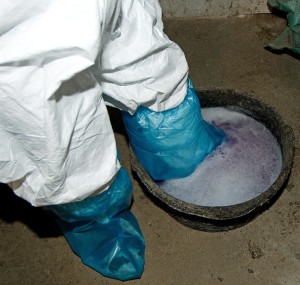Top biosecurity tips for Ontario goat producers
Click here for a PDF of this issue of the Goat Gazette.
Click here for biosecurity resources.
 It’s been well documented that implementing and following strict biosecurity procedures on-farm can dramatically reduce disease transmission and keep livestock healthy.
It’s been well documented that implementing and following strict biosecurity procedures on-farm can dramatically reduce disease transmission and keep livestock healthy.
Not only does this benefit the welfare of the animals, but it also directly impacts a farm’s profitability through lower mortality, more production, and better reproduction.
Biosecurity only works, however, if the protocols are actually followed. A well-known University of Guelph poultry researcher recently spoke about compliance rates in that industry, one where development and awareness of biosecurity, traceability, and food safety standards and practices is fairly advanced.
“Compliance studies with hidden cameras in the anterooms of farms to record what people actually did showed biosecurity compliance rates that were fairly low,” explained Dr. Michele Guerin at the 2015 Poultry Industry Council Research Day, with only 18 per cent of people respecting the line between clean and dirty areas in the barn and only about half changing their boots when moving between the two areas.
She added that although only a handful of research projects globally – in Japan and Nigeria – have looked at the benefits of biosecurity in the livestock industry from statistical standpoint, their results are striking.
Farms that paid attention to clothing and footwear saw their Avian Influenza risk decrease seven fold, whereas sharing of equipment between farms increased the disease transmission risk 30 times.
Keeping Ontario’s goat herds healthy
For Ontario’s goat industry, on-farm biosecurity practices for both dairy and meat goat operations have three main goals:
- Keeping disease out of a herd
- Reducing the spread of disease within a herd
- Preventing the spread of disease from one herd to another
This applies to endemic, economically significant production-limiting diseases like Caprine Arthritic Encephalitis (CAE), as well as catastrophic diseases like Foot and Mouth Disease, or zoonotic diseases like Q Fever that can also infect people.
Top biosecurity tips
Here are some top biosecurity tips from Ontario Goat that can help keep your herd disease-free:
- Know the disease status of surrounding herds so you are aware of the kinds of diseases in the area.
- If you bring new animals onto your farm, try to source livestock with disease-free status or the same or better health status for introduction into your herd. If possible, isolate new stock arriving for two to four weeks.
- Clean and disinfect transport trucks and trailers in between loads or ensure that your transporter has an appropriate protocol in place. If possible, avoid commingling animals during transport or sale.
- Use disease-negative bucks for breeding. Biosecurity caution should be utilized when sharing bucks.
- Restrict visitors into your barn. Post effective signage and visitor biosecurity requirements and use a log book to track visitors. This includes farm service providers – make them aware of your biosecurity protocols.
- Clean and disinfect equipment used for tattooing, hoof treating or animal health frequently.
- Consider contamination risks when moving healthy and sick animals through common alleyways in the barn. Move healthy animals first to avoid disease transmission.
- Isolate sick animals from the rest of the herd and ensure healthy and sick goats do not eat or drink from the same feed or water sources. Always work with the youngest to the oldest and healthy to sick.
- Use a rodent control program to keep feed and water free of contamination.
- Keep composting areas for deadstock away from regular manure storage.
Goats, biosecurity, and fall fairs
If you are taking goats off the farm to fairs or other events this fall, here are a few key points to help keep your animals healthy before, during and after:
- Only take healthy goats to fairs and events, and make sure your livestock trailers are cleaned and disinfected before leaving the farm.
- At the event, make sure animals have access to clean, fresh feed and water and that you use clean, new bedding materials.
- Keep hand sanitizer or sanitizing wipes handy for use by anyone who comes into contact with your goats.
- Any goats returning from an off-farm event should be kept in an isolation area away from the rest of the herd for 28 days to prevent introduction of disease. If any returning animals do become sick, contact your veterinarian as well as the organizers of the event you attended.
If you want to know more…
The Canadian Food Inspection Agency has developed two resources to help with on-farm biosecurity in the goat industry:
- the National Farm‐Level Biosecurity Standard for the Goat Industry that provides standards for goat meat and milk production as well as self‐evaluation checklists for your farm.
- the Biosecurity Planning Guide for Canadian Goat Producers, which includes guidelines, source material and best practices for getting a biosecurity plan in place.
To download your copy of the Livestock Purchasing Guide, a Movement and Isolation Checklist, and a biosecurity poster for goats, visit the Ontario Goat website here.
For further information on goat management, refer to Ontario Goats Best Management Practices for Commercial Goat Production.
For more information or resources on biosecurity for the goat industry, please contact us.
